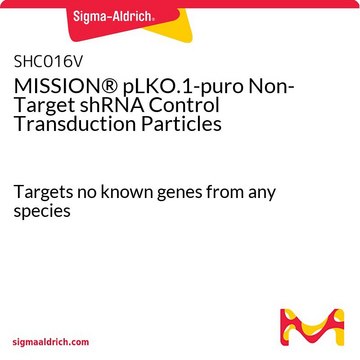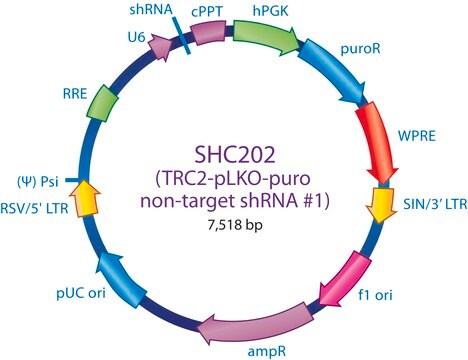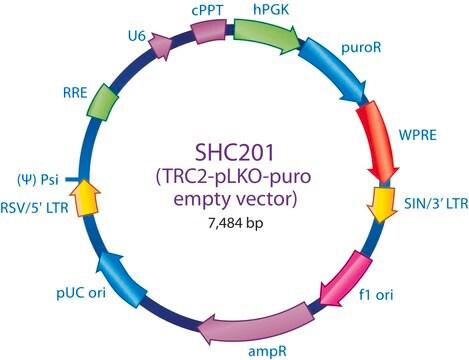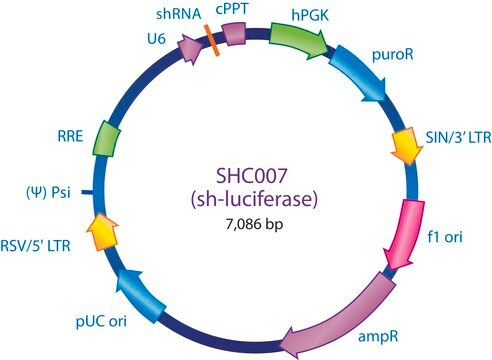SHC002H
MISSION® pLKO.1-puro Non-Mammalian shRNA Control Transduction Particles, High Titer
Targets no known mammalian genes
Synonym(s):
MISSION®, MISSION® Control Transduction Particles
Sign Into View Organizational & Contract Pricing
All Photos(1)
About This Item
UNSPSC Code:
41106609
NACRES:
NA.51
Recommended Products
Quality Level
product line
MISSION®
concentration
≥1x109 VP/ml (via p24 assay)
technique(s)
capture ELISA: 109 TU/mL using p24
shipped in
dry ice
storage temp.
−70°C
Looking for similar products? Visit Product Comparison Guide
Related Categories
General description
This shRNA non-mammalian control was designed using our Turbo GFP sequence and may cause some knockdown of tGFP. For maximum knockdown of tGFP, please refer to SHC004, SHC004V, SHC004H, SHC204, or SHC204V.
When conducting experiments using MISSION® shRNA clones, the proper controls should be a key element of your experimental design to allow for accurate interpretation of knockdown results. The MISSION Control Transduction Particles are a critical positive control to monitor transduction efficiency.
To see more application data, protocols, vector maps visit sigma.com/shrna.
To see more application data, protocols, vector maps visit sigma.com/shrna.
Application
To see more application data, protocols, vector maps visit sigma.com/shrna.
Components
High titer controls are provided as 10 x 20 μl aliquots.
Legal Information
MISSION is a registered trademark of Merck KGaA, Darmstadt, Germany
recommended
Product No.
Description
Pricing
Storage Class Code
12 - Non Combustible Liquids
WGK
WGK 3
Flash Point(F)
Not applicable
Flash Point(C)
Not applicable
Choose from one of the most recent versions:
Certificates of Analysis (COA)
Lot/Batch Number
Don't see the Right Version?
If you require a particular version, you can look up a specific certificate by the Lot or Batch number.
Already Own This Product?
Find documentation for the products that you have recently purchased in the Document Library.
Customers Also Viewed
Nicole T Watt et al.
Diabetes, 66(11), 2808-2821 (2017-08-24)
Shc homology 2-containing inositol 5' phosphatase-2 (SHIP2) is a lipid phosphatase that inhibits insulin signaling downstream of phosphatidylinositol 3-kinase (PI3K); its role in vascular function is poorly understood. To examine its role in endothelial cell (EC) biology, we generated mice
Min Ling et al.
Cell & bioscience, 7, 27-27 (2017-05-27)
Bone degenerative disorders like osteoporosis may be initiated by age-related shifts in anabolic and catabolic responses that control bone homeostasis. Although there are studies suggesting that metabolic changes occur with stem cell differentiation, the molecular mechanisms governing energy metabolism and
Karin M E Andersson et al.
Oncotarget, 6(24), 20043-20057 (2015-09-08)
Follicular T helper (Tfh) cells are recognized by the expression of CXCR5 and the transcriptional regulator Bcl-6. Tfh cells control B cell maturation and antibody production, and if deregulated, may lead to autoimmunity. Here, we study the role of the
Our team of scientists has experience in all areas of research including Life Science, Material Science, Chemical Synthesis, Chromatography, Analytical and many others.
Contact Technical Service








